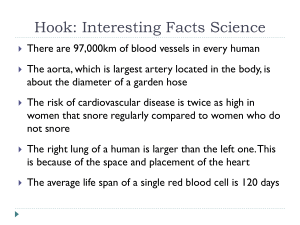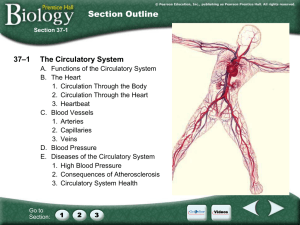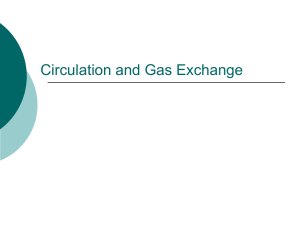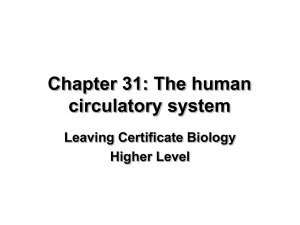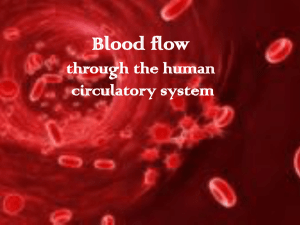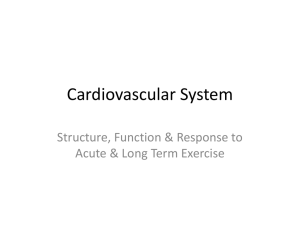Circulatory System
advertisement
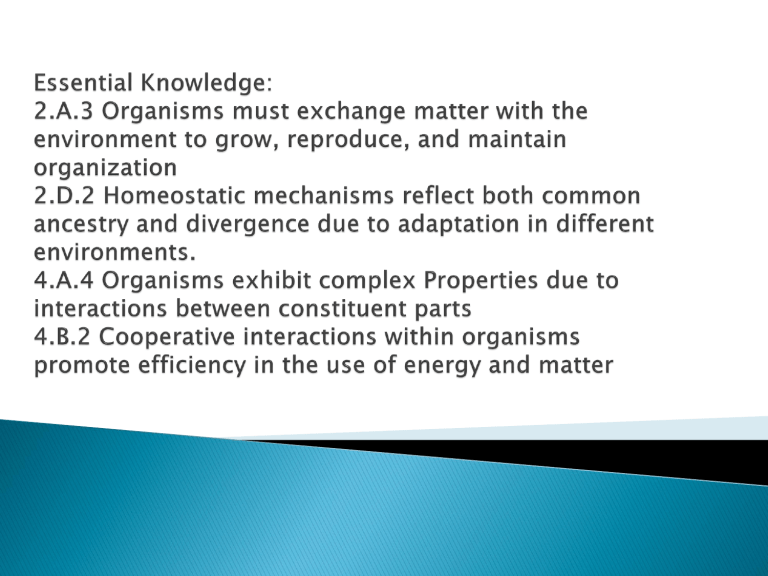
How do simple organisms like jelly fish and flat worms exchange reactants and products of cellular respiration? ◦ Simple animals have a body wall that is only two cells thick and that encloses a gastrovascular cavity ◦ This cavity functions in both digestion and distribution of substances throughout the body ◦ Materials can diffuse in or out of the gastrovascular cavity as needed. Fig. 42-2 Circular canal Mouth Pharynx Mouth Radial canal (a) The moon jelly Aurelia, a cnidarian 5 cm 2 mm (b) The planarian Dugesia, a flatworm How do more complex organisms exchanges the reactants and products of cellular respiration? ◦ They have either an open or closed circulatory system. How does an open circulatory system work? ◦ In insects, other arthropods, and most molluscs, blood bathes the organs directly in an open circulatory system ◦ In an open circulatory system, there is no distinction between blood and interstitial fluid, and this general body fluid is more correctly called hemolymph How does a closed circulatory system work? ◦ In a closed circulatory system, blood is confined to vessels and is distinct from the interstitial fluid ◦ Closed systems are more efficient at transporting circulatory fluids to tissues and cells What do we call our circulatory system? ◦ Humans and other vertebrates have a closed circulatory system, often called the cardiovascular system ◦ The three main types of blood vessels are arteries, veins, and capillaries Fig. 42-3 Heart Hemolymph in sinuses surrounding organs Pores Heart Blood Interstitial fluid Small branch vessels In each organ Dorsal vessel (main heart) Tubular heart (a) An open circulatory system Auxiliary hearts Ventral vessels (b) A closed circulatory system What are the major components of the vertebrate circulatory system? ◦ Arteries branch into arterioles and carry blood to capillaries ◦ Networks of capillaries called capillary beds are the sites of chemical exchange between the blood and interstitial fluid ◦ Venules converge into veins and return blood from capillaries to the heart ◦ Vertebrate hearts contain two or more chambers ◦ Blood enters through an atrium and is pumped out through a ventricle Fig. 42-4 Gill capillaries Single circulatory loop with a 2 chambered heart Heart Artery Gill circulation Ventricle Atrium Vein Systemic circulation Systemic capillaries Fig. 42-5 Double circulation with a 4 chambered heart Double heart circulation w/ 3 chambered Amphibians Reptiles (Except Birds) Mammals and Birds Lung and skin capillaries Lung capillaries Lung capillaries Pulmocutaneous circuit Atrium (A) Ventricle (V) Right systemic aorta Atrium (A) Right Systemic circuit Left Systemic capillaries Pulmonary circuit A V Right Pulmonary circuit A A V Left Left systemic aorta Systemic capillaries Double circulation with a 3 chambered heart – ventricle partially divided A V V Right Left Systemic circuit Systemic capillaries How does blood flow in a mammal? ◦ Blood begins its flow with the right ventricle pumping blood to the lungs ◦ In the lungs, the blood loads O2 and unloads CO2 ◦ Oxygen-rich blood from the lungs enters the heart at the left atrium and is pumped through the aorta to the body tissues by the left ventricle ◦ The aorta provides blood to the heart through the coronary arteries ◦ Blood returns to the heart through the superior vena cava (blood from head, neck, and forelimbs) and inferior vena cava (blood from trunk and hind limbs) ◦ The superior vena cava and inferior vena cava flow into the right atrium Fig. 42-6 Superior vena cava Capillaries of head and forelimbs 7 Pulmonary artery Pulmonary artery Capillaries of right lung Aorta 9 3 2 Capillaries of left lung 3 4 11 Pulmonary vein Right atrium 1 Pulmonary vein 5 Left atrium 10 Right ventricle Left ventricle Inferior vena cava Aorta 8 Capillaries of abdominal organs and hind limbs Fig. 42-7 Pulmonary artery Aorta Pulmonary artery Right atrium Left atrium Semilunar valve Semilunar valve Atrioventricular valve Atrioventricular valve Right ventricle Left ventricle How does the heart contract? What are the two phases of the cardiac cycle? ◦ The contraction, or pumping, phase is called systole ◦ The relaxation, or filling, phase is called diastole What is another name for the heart rate? ◦ The heart rate, also called the pulse, is the number of beats per minute Fig. 42-8 2 Atrial systole; ventricular diastole Semilunar valves closed 0.1 sec AV valves open 1 Atrial and ventricular diastole 0.4 sec Semilunar valves open 0.3 sec AV valves closed 3 Ventricular systole; atrial diastole What are the four valves in the heart called? And what is their purpose? ◦ Four valves prevent backflow of blood in the heart ◦ The atrioventricular (AV) valves separate each atrium and ventricle ◦ The semilunar valves control blood flow to the aorta and the pulmonary artery ◦ The “lub-dup” sound of a heart beat is caused by the recoil of blood against the AV valves (lub) then against the semilunar (dup) valves How does the heart maintain its rhythmic beat? ◦ The sinoatrial (SA) node, or pacemaker, sets the rate and timing at which cardiac muscle cells contract ◦ Impulses from the SA node travel to the atrioventricular (AV) node ◦ At the AV node, the impulses are delayed and then travel to the Purkinje fibers that make the ventricles contract ◦ The pacemaker (SA node) is influenced by nerves, hormones, body temperature, and exercise Fig. 42-9-5 1 Pacemaker generates wave of signals to contract. SA node (pacemaker) ECG 2 Signals are delayed at AV node. AV node 3 Signals pass to heart apex. Bundle branches Heart apex 4 Signals spread throughout ventricles. Purkinje fibers How is the structure of blood vessels adapted to transport material throughout the body? ◦ Capillaries have thin walls, the endothelium plus its basement membrane, to facilitate the exchange of materials ◦ Arteries and veins have an endothelium, smooth muscle, and connective tissue ◦ Arteries have thicker walls than veins to accommodate the high pressure of blood pumped from the heart ◦ In the thinner-walled veins, blood flows back to the heart mainly as a result of muscle action, valves prevent back flow Fig. 42-10 Artery Vein SEM 100 µm Basal lamina Endothelium Smooth muscle Connective tissue Valve Endothelium Capillary Smooth muscle Connective tissue Artery Vein Capillary 15 µm Red blood cell Venule LM Arteriole How does blood flow change as it moves from arteries to capillaries to veins? ◦ Blood flow is fast in arteries due to pumping of the heart ◦ Blood flow slows in capillaries as the volume from one artery spreads to feed an entire capillary bed – this is good it slows things down and allows for exchange of materials ◦ Blood flow increases slightly in veins due to decreased surface area Venae cavae Veins Venules Capillaries Arterioles Arteries 120 100 80 60 40 20 0 Aorta Velocity (cm/sec) 50 40 30 20 10 0 Pressure (mm Hg) Area (cm2) Fig. 42-11 5,000 4,000 3,000 2,000 1,000 0 Systolic pressure Diastolic pressure How can blood flow through capillaries be controlled? ◦ Two mechanisms regulate distribution of blood in capillary beds: Contraction of the smooth muscle layer in the wall of an arteriole constricts the vessel Precapillary sphincters control flow of blood between arterioles and venules Fig. 42-15 Precapillary sphincters Thoroughfare channel Capillaries Arteriole Venule (a) Sphincters relaxed Arteriole (b) Sphincters contracted Venule Where does the critical exchange of nutrients and gasses takes place in the circulatory system? ◦ The critical exchange of substances between the blood and interstitial fluid takes place across the thin endothelial walls of the capillaries ◦ The difference between blood pressure and osmotic pressure drives fluids out of capillaries at the arteriole end and into capillaries at the venule end Fig. 42-16 Body tissue Capillary INTERSTITIAL FLUID Net fluid movement out Net fluid movement in Direction of blood flow Pressure Blood pressure Inward flow Outward flow Osmotic pressure Arterial end of capillary Venous end

